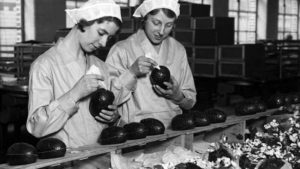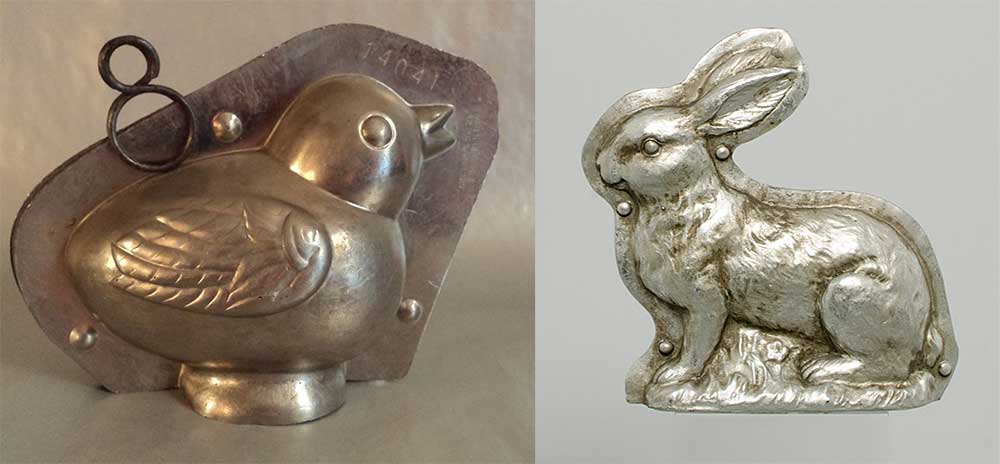Small Home Gazette, Spring 2021
What Did the Easter Bunny Bring You?
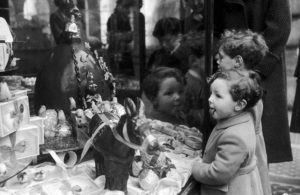 Easter is a major candy holiday, second only to Halloween, but how did the tradition of the Easter Bunny AND candy AND baskets come to be?
Easter is a major candy holiday, second only to Halloween, but how did the tradition of the Easter Bunny AND candy AND baskets come to be?
The Easter Bunny, the recognizable symbol of Easter since the 1700s, was brought to the U.S. by German immigrants. Historians believe a rabbit was chosen because it was an ancient symbol of new life, and therefore, spring.
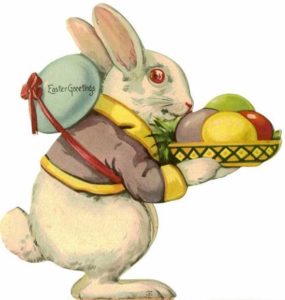 German immigrants told stories about a hare (the Osterhase or Easter Hare) who would leave brightly colored eggs for all good children on Easter morning. Odd as it sounds, German folklore said the Osterhase laid the eggs.
German immigrants told stories about a hare (the Osterhase or Easter Hare) who would leave brightly colored eggs for all good children on Easter morning. Odd as it sounds, German folklore said the Osterhase laid the eggs.
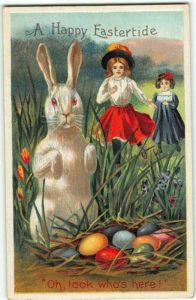 Children put out stockings and hats to be filled, and built nests of leaves and sticks in the yard. The latter led to the tradition of the Easter egg hunt. In the late 19th century, the Easter Bunny got its official name, and baskets began to be used—making room for candy and toys, in addition to eggs.
Children put out stockings and hats to be filled, and built nests of leaves and sticks in the yard. The latter led to the tradition of the Easter egg hunt. In the late 19th century, the Easter Bunny got its official name, and baskets began to be used—making room for candy and toys, in addition to eggs.
So, what did the Easter Bunny bring to bungalow era children? Several well-known candies found their way into baskets, and some of the most popular are below.
Candy Eggs
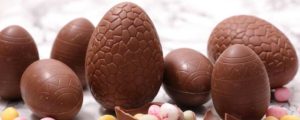 Dyed eggs were the first gifts from the bunny, followed by chocolate eggs handcrafted by European candy makers in the 1800s. The egg was a symbol of good luck and new life (and remember, the eggs were said to be laid by the hare, the other symbol of new life).
Dyed eggs were the first gifts from the bunny, followed by chocolate eggs handcrafted by European candy makers in the 1800s. The egg was a symbol of good luck and new life (and remember, the eggs were said to be laid by the hare, the other symbol of new life).
By the late 1800s, candy makers in the U.S. were also offering chocolate eggs, both hollow and filled; jelly eggs; and detailed panorama eggs made of sugar and icing. Chocolate eggs are the oldest candy tradition and continue to be a popular candy associated with Easter.
What about those Cadbury Crème Eggs? John Cadbury from Birmingham, England, made his first eggs in 1875. Made from dark chocolate, the eggs were filled with sugar-coated chocolate “drops” known as “dragees” (sugar-coated nuts). The first Cadbury cream-filled egg appeared in 1923 but the Cadbury Crème Egg as we know it did not hit the U.S. market until 1988.
Chocolate Bunnies
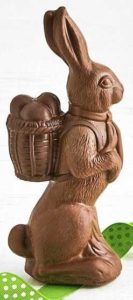 Chocolate bunnies were first handcrafted in the 1830s, using tin-coated metal sheets. Rabbit-shaped chocolate molds started to be used in about 1890, making the chocolate easier to work with. The molds, in the hands of skilled chocolate makers, helped to create finely detailed bunnies.
Chocolate bunnies were first handcrafted in the 1830s, using tin-coated metal sheets. Rabbit-shaped chocolate molds started to be used in about 1890, making the chocolate easier to work with. The molds, in the hands of skilled chocolate makers, helped to create finely detailed bunnies.
Early 20th century innovations in candy making introduced more chocolate shapes—chicks and lambs as well as bunnies in intricate poses. In 1939, hollow versions of these molds were developed to make animal-shaped “shells” that were less expensive and enabled candy makers to produce unique Easter candy in much larger quantities.
Panorama Eggs
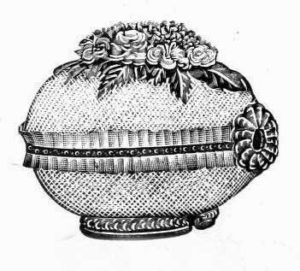 Elaborate panorama eggs—hollow, sugar-shelled eggs containing miniature scenes that could be viewed through a peephole—first appeared in Victorian England and became popular in the U.S. in the 1890s.
Elaborate panorama eggs—hollow, sugar-shelled eggs containing miniature scenes that could be viewed through a peephole—first appeared in Victorian England and became popular in the U.S. in the 1890s.
 The eggs were made by packing a sugar mixture into half-egg molds; allowing them to harden for several days; and then scooping out the inside until a thin shell remained. The tip of each half was carefully sliced off, later to become the peephole when the egg was reassembled. A small amount of royal icing was piped into the bottom half of the egg to anchor miniature bunnies, chicks, flowers, etc., all painstakingly replicated in royal icing. Icing was used again to glue the two halves together and to decorate the outside of the egg.
The eggs were made by packing a sugar mixture into half-egg molds; allowing them to harden for several days; and then scooping out the inside until a thin shell remained. The tip of each half was carefully sliced off, later to become the peephole when the egg was reassembled. A small amount of royal icing was piped into the bottom half of the egg to anchor miniature bunnies, chicks, flowers, etc., all painstakingly replicated in royal icing. Icing was used again to glue the two halves together and to decorate the outside of the egg.
Women frequently made these eggs as Easter treasures to give to friends and family, and the eggs were handed down as family heirlooms. Lucky was the child who found one in his or her basket. Today, you can find confectioners who sell hand-made panorama eggs or, if you are adventurous, you can find step-by-step instructions and a recipe online.
Marshmallow
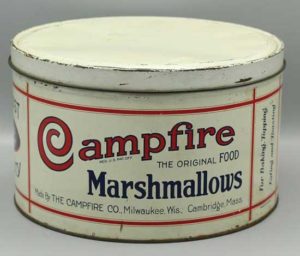 Marshmallow became a popular candy in the early 1900s, when candy makers developed recipes that used low-cost ingredients like gelatin. Shaped marshmallows were made in quantity and sold in tins, and by the 1920s, many companies were selling bunny- and chick-shaped marshmallow confections.
Marshmallow became a popular candy in the early 1900s, when candy makers developed recipes that used low-cost ingredients like gelatin. Shaped marshmallows were made in quantity and sold in tins, and by the 1920s, many companies were selling bunny- and chick-shaped marshmallow confections.
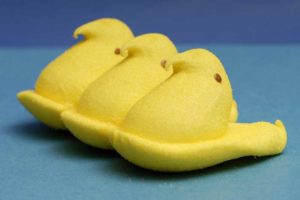 The original Peep was a product of the Rodda Candy Company, in Pennsylvania, where marshmallow chicks were laboriously piped by hand using a pastry bag, and then finished with painted eyes and marshmallow wings.
The original Peep was a product of the Rodda Candy Company, in Pennsylvania, where marshmallow chicks were laboriously piped by hand using a pastry bag, and then finished with painted eyes and marshmallow wings.
In 1953, Rodda Candy was acquired by Just Born, a company that eventually mechanized and streamlined the Peeps process, and today, the original yellow Peep chick appears in dozens of colors and shapes.
Jelly Beans
The early 20th century saw jelly beans added to the Easter tradition. The “jelly” part of a jelly bean was actually Turkish delight, a chewy, cornstarch-thickened sweet that was created by an Istanbul confectioner in 1777. It reached America in the late 19th century.
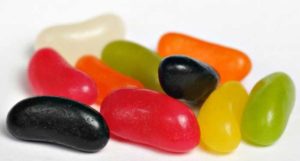 Some unknown U.S. candy maker had the bright idea of making a penny-candy version of Turkish delight by cutting it into tiny pieces (why a “bean” shape was chosen is unknown) and giving them a hard candy coating. The oval-shaped candies were called “jelly beans” by the 1890s. (One company marketed them as “Jelly Eggs” in the 1920s.) Jelly beans were the first bulk candy sold by weight.
Some unknown U.S. candy maker had the bright idea of making a penny-candy version of Turkish delight by cutting it into tiny pieces (why a “bean” shape was chosen is unknown) and giving them a hard candy coating. The oval-shaped candies were called “jelly beans” by the 1890s. (One company marketed them as “Jelly Eggs” in the 1920s.) Jelly beans were the first bulk candy sold by weight.
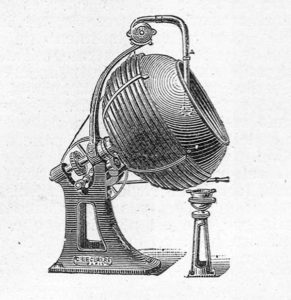 The sugar coating protected the soft interior and created something a child (or adult) could carry in a pocket. To create the smooth coating, the bean centers were moistened with sugar syrup and tossed around in a piece of equipment that resembled a cement mixer. The colliding beans beat the sugar into a thin candy coating.
The sugar coating protected the soft interior and created something a child (or adult) could carry in a pocket. To create the smooth coating, the bean centers were moistened with sugar syrup and tossed around in a piece of equipment that resembled a cement mixer. The colliding beans beat the sugar into a thin candy coating.
Enjoyed for their bright colors as well as their flavor, the egg-shaped jelly beans were, and still are, popular in Easter baskets. (By the way, Jelly Belly beans are quite different. The original jelly beans had no coloring or special flavoring in the center. Jelly Belly beans, created in 1976, are smaller, softer, and have intense, and sometimes odd, flavors throughout.)
The chocolate bunny was a special treat in the basket. I wonder if children from the bungalow era faced that familiar question—do I bite off the bunny ears or the tail first?









